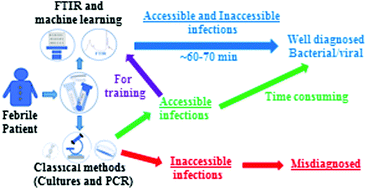Diagnosis of inaccessible infections using infrared microscopy of white blood cells and machine learning algorithms†
Abstract
Physicians diagnose subjectively the etiology of inaccessible infections where sampling is not feasible (such as, pneumonia, sinusitis, cholecystitis, peritonitis), as bacterial or viral. The diagnosis is based on their experience with some medical markers like blood counts and medical symptoms since it is harder to obtain swabs and reliable laboratory results for most cases. In this study, infrared spectroscopy with machine learning algorithms was used for the rapid and objective diagnosis of the etiology of inaccessible infections and enables an assessment of the error for the subjective diagnosis of the etiology of these infections by physicians. Our approach allows for diagnoses of the etiology of both accessible and inaccessible infections as based on an analysis of the innate immune system response through infrared spectroscopy measurements of white blood cell (WBC) samples. In the present study, we examined 343 individuals involving 113 controls, 89 inaccessible bacterial infections, 54 accessible bacterial infections, 60 inaccessible viral infections, and 27 accessible viral infections. Using our approach, the results show that it is possible to differentiate between controls and infections (combined bacterial and viral) with 95% accuracy, and enabling the diagnosis of the etiology of accessible infections as bacterial or viral with >94% sensitivity and > 90% specificity within one hour after the collection of the blood sample with error rate <6%. Based on our approach, the error rate of the physicians’ subjective diagnosis of the etiology of inaccessible infections was found to be >23%.



 Please wait while we load your content...
Please wait while we load your content...